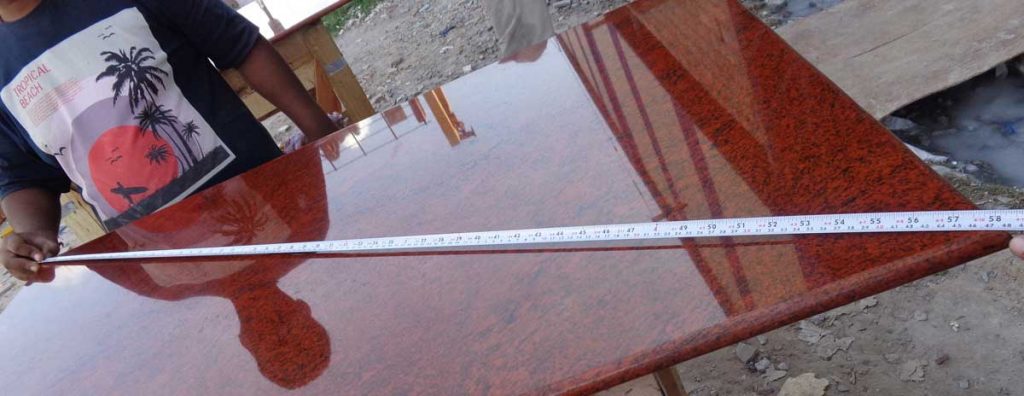Blog
How to check if the granite is of good quality?
Granite is a high-end material that is valued for its sturdiness and unique patterns and shapes. It is a naturally occurring volcanic rock that is extracted from quarries all over the world. There is a potential that the granite’s quality will vary as a result. You may make better choices by using basic tactics and learning what to watch out for. Knowing that granite slabs cost between $80 and $150 per square foot might motivate you to do better.
Different Grades of Granite
Granite is graded according to a standard that makes it simple to distinguish between high- and low-quality materials. The following three classes or tiers are the most typical, however, some vendors may utilize more.
First-grade entry level (BUILDER OR COMMERCIAL GRADE)
The Grade 1 granite is the group’s thinnest material. Because of the possibility that their thickness alone would not be able to survive extensive use, they are typically seen with plywood backings or some other form of support. They are also pre-fabricated and frequently found in moderately priced housing complexes. Moreover, Grade 1 Granite has simpler patterns and more neutral hues.
LOOKS
As was previously noted, patterns and designs on lower quality or more common granite stones are simpler and more prevalent as you move up the pricing scale. This natural stone is highly valued for its beauty.
Other, simpler factors can also be taken into account under the visual criteria in addition to aesthetics when sourcing granite from leading granite suppliers. The top’s regularity and straightness need to be carefully examined since they have a significant influence on how well the granite slab works.
Moreover, keep an eye out for any cavities, holes, cracks, chips, and scratches. These could be a sign of low stone quality or bad cutting techniques when the granite was being cut. In either case, avoid these warning signs.
POROSITY
Granite is a porous substance by nature. Nonetheless, measures have been taken to make the surface less absorbent, glossy, and smooth. Extremely porous stones are able to absorb acids and other chemicals, which are typically found in food and may result in fading and other sorts of harm.
ORIGIN
The majority of entry-level stones are prefabricated and imported from India. They are then marketed straight to large-format retailers or high-volume importers. They are disseminated for commercial purposes.
Granite of middle to high grade often originates in India or Brazil.
THICKNESS
Granite slabs at the entry-level are thin. They are typically 3/8 inch thick and come with a plywood backing for additional strength.
The higher-grade granite may be marketed as thicker, middle and higher-grade granite are typically 34 inches thick.
Checking Granite Quality
Even attempting to evaluate the quality of a granite block may be difficult given the wide range of patterns and hues available. This task could be very difficult for a first-time buyer who is in contact with several granite suppliers. Get assistance if you can from a friend or expert who has greater expertise. Here are a few easy things you can do to make sure you choose wisely to get started. After all, the investment ranges from $80 to $150 per square foot.

STEP 1: Visually scrutinize the granite block in great detail. Check the item for any flaws, such as scratches, dents, discolorations, cracks, and chips. Keep an eye out for the surfaces’ homogeneity as well. Check the edges to see if they are squared off. For a newbie, it could be challenging to eyeball; use a straight edge as a guide.
A better design or pattern for your particular kitchen will not necessarily be available as you move up the pricing scale. Think about the hues and patterns that might go well with your overall theme. You could come upon a valuable jewel for a reasonable cost.
STEP 2: Step two is to confirm that the measurements are accurate. Accepting a slab that was not cut to the dimensions you requested is unacceptable. That will only result in hardships and sacrifices on your end.
STEP 3: Measure the thickness. Entry-level slabs come with a wood backing and are sold quite thin. From moderate to high grade, there isn’t much of a variation in thickness, although high-grade granite can come in thicker varieties.
Yet this is not simply a random pointer. The strength of granite increases with its thickness.
STEP 4:To assess the polish quality of the granite, gently rub a penny across the polished surface. Low-quality polish or sealer may be used on slabs that are simple to scrape.
STEP 5: By exposing the granite to various chemicals, the granite’s quality may be evaluated. Granite reacts to lemons in a very particular way that allows it to identify a few traits about you. If the lemon juice is absorbed, the material is porous or improperly polished.
